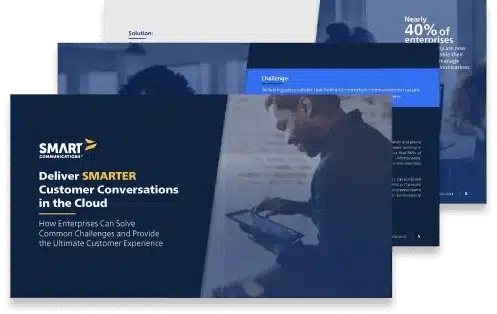Your Archive Strategy Isn’t Ready for the AI Era

By Scott Draeger, SVP of Product Marketing and Vertical Solutions at Smart Communications
When you think about what you archive, you expect your data to be static, stored, and tucked away. But in an environment of constant disruption, your archive needs to be searchable, connected, and ready on demand.
Too often, organizations assume their archive solution still offers predictable costs, proven technology, and lasting relationships. That’s the complacency talking, because your archive systems and strategies have likely been in place for 10-plus years.
Your archive and retrieval strategy is probably not ready for the AI Era, and it needs your fresh thinking now. Trends toward customer self-service and AI summarization technology put retrieval-optimized archive technologies like SmartHUB™ in position to transform your organization when legacy approaches may fail to scale while costing you more than you anticipate.
Why Is Older Technology Problematic?
If you’ve had your archive technology longer than a full retention period, you may consider it reliable and dependable. This may have been true for the scale you operated at when your predecessors initially selected the technology, but a lot has changed since then.
Most archive solutions deployed around the time of the Sarbanes-Oxley Act were architected around the challenges of the day, which were rising retention periods and high storage costs. The use cases of that era focused mainly on storage and less on retrievals, so they missed opportunities to:
- Incorporate metadata for better search and context
- Manage multiple file formats
- Reduce retrieval times
As the context window of LLMs increases, so does the LLM’s appetite for data, documents, and attachments. Some legacy systems attempt to mask these limitations by adding real-time cache technology that sits on top of the legacy architecture. This introduces complex data mapping and prevents your archive from being a single source of truth.
Today, customers requesting a document from an archive system have attention spans that are in the hundredths of a second. As your CX and Operations teams demand you move more of your customer experiences to self-service, your retrieval needs will exponentially increase. You may be archiving more types of communications from a wider variety of channels. When you add AI summarization to the mix, you may be summarizing thousands or tens of thousands as many documents. This strain will inevitably test your system, adding further delays that erode customer trust.
Why Will Costs Be Unpredictable?
Legacy archive solutions were priced around the assumption that storage activity was common, and retrieval activity was rare. To offer more predictability to clients, models about the ratio of storage to retrieval drove pricing discussions. Since storage outnumbered retrievals, vendors and customers agreed that focusing the discussion on storage resulted in a more predictable arrangement for both parties. The storage to retrieval ratio was thousands, or even tens of thousands, to one.
As organizations look to reduce costs through automation and self-service, the archive’s storage to retrieval ratio starts to change. Customers are using the portal to look at documents and communications in the archive to verify a transaction, share information, or understand more before they expand their relationship. The more they look at older records, the more retrievals they create. Add in AI summarization, and now an AI Agent may read five to 20 documents from your archive to answer a question. This could boost retrieval activity hundreds, or even thousands, of times.
If your legacy offering attempts to offer a real-time cache solution to reduce retrieval costs, that complexity will come with an additional price tag. As your complexity increases, so does your budget.
What About My Valuable Vendor Relationships?
As you look at your legacy technology provider, you may put a lot of value on the relationships you have with your account team. But if your account team hasn’t helped you plan for the impacts that customer self-service and AI summarization place on your archive system, they may not be the best partner. In fact, your account team may eagerly anticipate your CX and AI initiatives, because an extra zero (or two, or three, or four) on your retrieval counts might be the expansion that gets them to President’s Club.
There’s a Better Way Forward
The challenges with legacy archive systems aren't insurmountable—rather, they require a fundamentally different approach. Sophisticated archive solutions like SmartHUB enable rapid migration, migrating hundreds of millions of pages (or more) per week with scalable cloud-based ingestion capabilities. You can retire your legacy technology in months, while bringing the benefits of retrieval-optimized archiving to your customers, employees, and even AI agents.
To learn more about how Smart Communications helps customers bring their archive and retrieval strategy into the AI era, check out the video below and request a demo of SmartHUB today.



